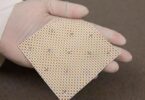Biotechnology in food packaging, with techniques for detection and elimination of contaminants through the manufacturing of packaging for their protection.
Biotechnology through the technique of detecting and eliminating contaminants improves food safety by allowing the manufacture of packaging that protects food from oxygen and light.
The procedure consists of the use of enzymes and microorganisms to develop new materials and biotechnological processes.
First of all, it can be applied to food packaging, hydrocarbons, chemicals, cosmetics, advanced biofuels, renewable fuels, textiles, etc.
And in second place, it allows us to develop new and more effective drugs, regenerative therapies, vaccines, antibiotics, molecular diagnostic techniques and genetic engineering techniques to treat diseases and so on.
Consequently, food containers are manufactured with the objective of containing food packaged in them to protect them from external agents until the moment of use.
The main characteristics are to offer protection, resistance to manipulation and respond to physical, chemical or biological protection needs.
High pressure food packaging consists of applying the container seal and then subjecting the food to high levels of hydrostatic pressure, for a few minutes and uniformly.
This system has numerous benefits: it eliminates any possible presence of microorganisms
The use of biotechnology promotes immense benefits, which are related to greater food production, with greater quality and nutritional value.
Biotechnology has proven to be a powerful tool for creating better foods for the consumer, creating more resistant, more productive and more environmentally friendly crops.
This is one of the great hopes to fight hunger, especially in the poorest regions of the world.
We can say that this type of biotechnology technique covers the chemical composition of food, production processes and the nutritional impact on the health of consumers.
Characteristics:
This type of technology is characterized by increasing agricultural productivity and strengthening the resistance of plants to pests or climate disasters.
Agricultural biotechnology is projected with genetic manipulation techniques that promise to multiply power with some risks.
Biology is applied to food through molecular biology in the agri-food industry.
Advantages:
- Reduction of pesticides that allows the use of more environmentally friendly herbicides.
- Conservation of soil quality through the use of conservation tillage.
- Decreases nutrients from agricultural runoff.
- Paper or cardboard packaging: their ecological and biodegradable nature has also made them one of the most popular and sustainable options. In addition, they are customizable and extremely versatile, as they allow you to wrap, preserve and transport dry or slightly moist foods with great ease.
- The packaging helps protect against: Damage caused by drops, shocks or vibrations.
- Environmental conditions such as temperature, humidity, light, dirt or dust.
- Extend the useful life of the product.
- Slow down enzymatic and microbial reactions.
- Reduce weight losses due to evaporation.
- Enable more hygienic transportation and storage.
There are three types of packaging:
- Primary Packaging, are those that are in direct contact with the product or its contents.
- Secondary Container: contain one or more primary containers.
- Tertiary Packaging: packaging that is commonly used in warehouses to ship products in secondary packaging.
There are mainly 6 packaging materials, including paper and cardboard packaging, plastic packaging, metal packaging, glass packaging, wooden packaging, and textile packaging.
Packaging functions:
- Keep the product for longer.
- Transport the product more easily.
- House the product.
- Protect its intact qualities.
- Provide mechanical protection to the product (bumps and falls) and against external agents that may alter its physical-chemical and organoleptic properties (odor and flavor).
- Recycled plastic rPET is considered to represent the most sustainable option compared to its counterpart materials. They stand out for their great resistance to humidity and high temperatures, making them the preferred choice for packaging both liquid and solid foods.
FONT
https://ieqfb.com/biotecnologia-alimentaria-aplicacion-formacion/
OTHER ARTICLES OF INTEREST
Types of biodegradable plastics of biological origin used in advances in medicine.
Types of biodegradable plastics of biological origin used in advances in medicine.









